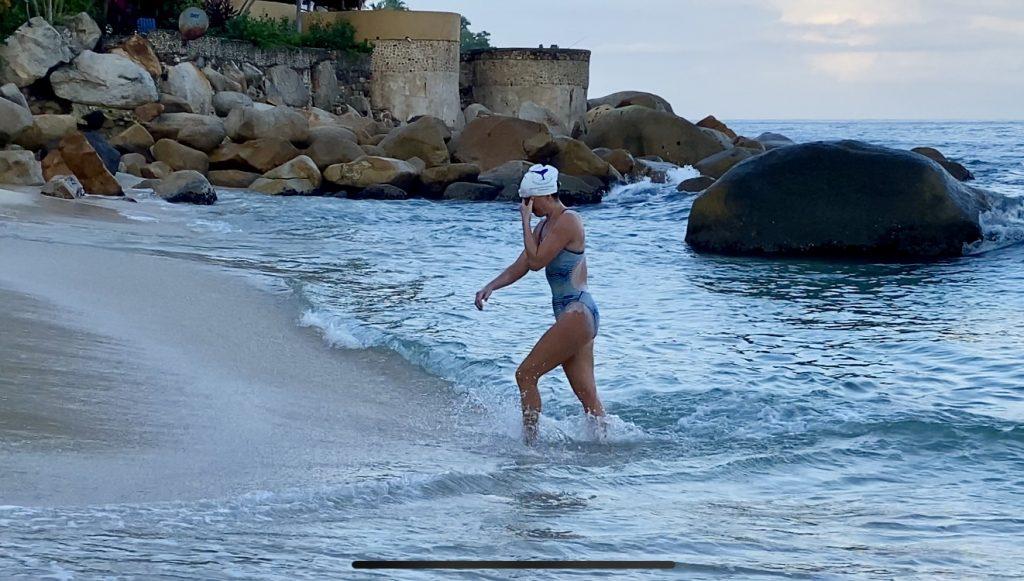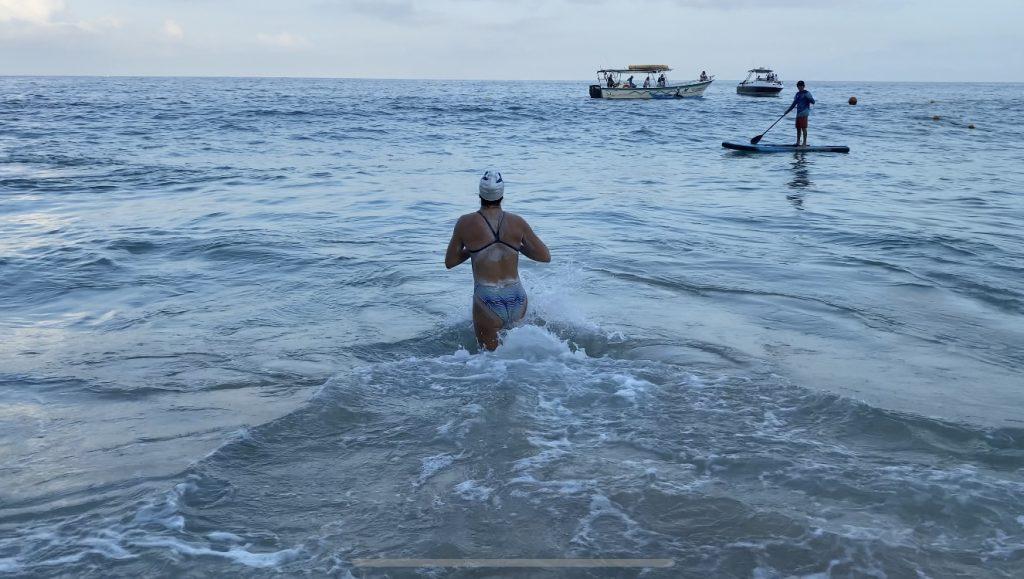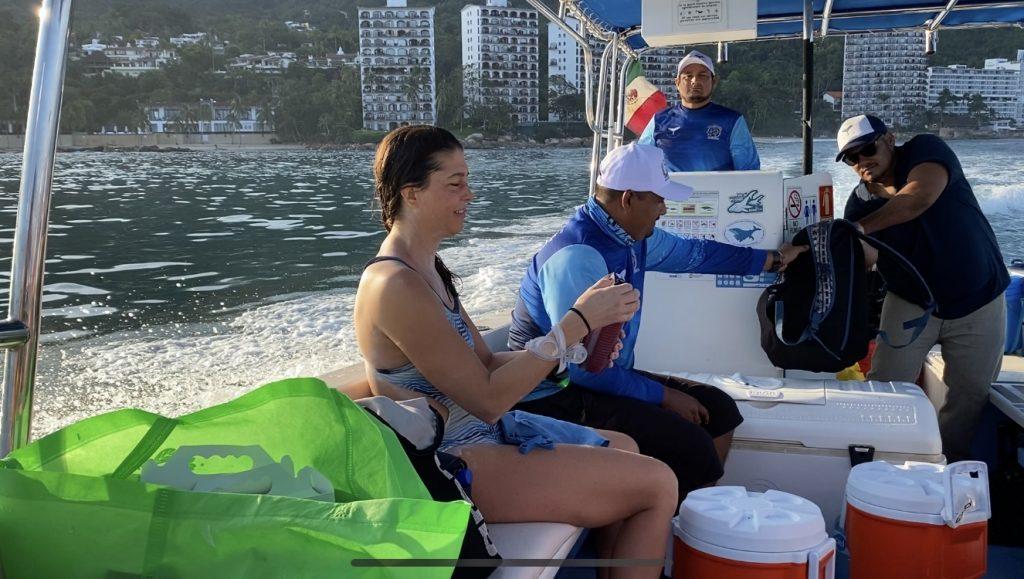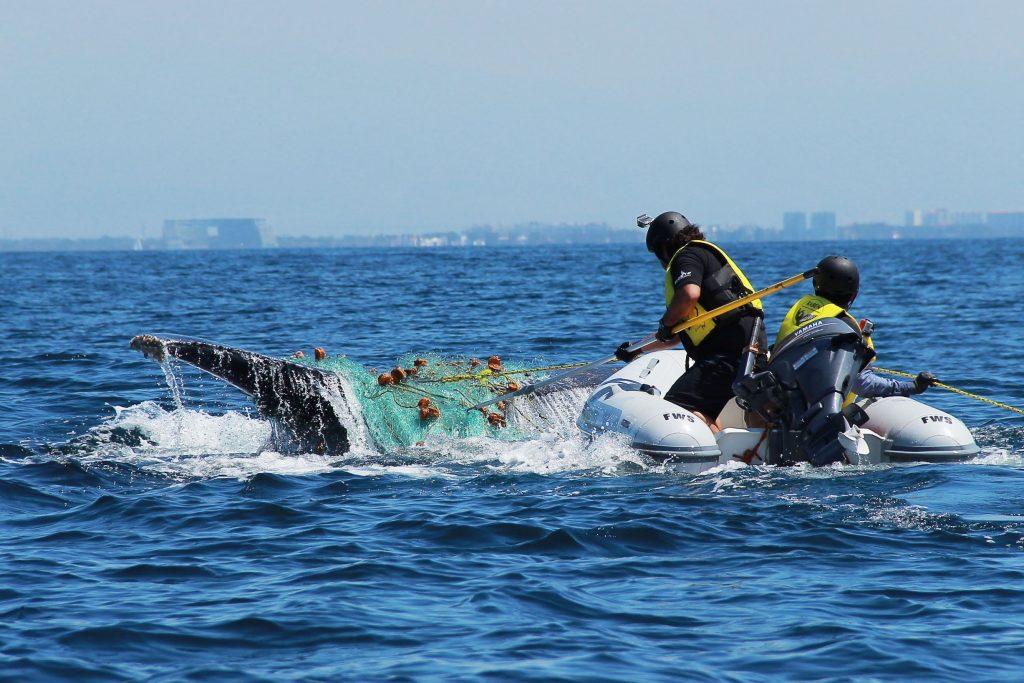
Swim for the whales
Daniel Shailer shares how Stephanie Montero Bending swam across Banderas Bay, Mexico, for the first time, galvanising a community of swimmers
Stephanie Montero Bending must be easy to buy presents for. She really likes whales.
When we meet on Saturday at a cafe in the south of Mexico City she’s wearing a whale tail baseball cap, blue t-shirt with two whales, and a whale tail necklace (gifted from a friend who knows she likes whales). She picks up her phone to find a video of whales. Her background is a humpback whale, breaching backwards with its white, ribbed belly up to the sun.
Something about seeing a whale in the wild, according to Montero, levels people. “It’s like taking off a mask,” she says. “You have to shout – in a way you become you.”
Still, one Saturday evening, 18 November, Montero went further than most for whales. At 5:30pm, she started swimming from Islas Marietas in the mouth of Banderas Bay, on the Pacific coast of Mexico, heading for the mainland. 14 hours, 30 minutes and 58 seconds later she arrived on a beach in Puerto Vallarta, exhausted and crying with joy.

Alongside her swim, Montero brought together over a thousand other swimmers in a weeklong fundraiser for ECOBAC: a charity researching and rescuing whales from discarded fishing nets in the bay.
No one has swum the length of Banderas Bay before. In 2020 another Mexican swimmer, Mariel Hawley, swam across the mouth of the bay in a little over nine hours. For Hawley the swim came after an accomplished career in open water, culminating in 2019 when she became the 15th person to complete the Oceans Seven (a challenge comprising the English Channel and six other sea swims from Japan and New Zealand to California).
Montero has, by her own admission, a little less experience. She only took to open water swimming in 2020, after a running injury spiked her plans to run a half marathon with a friend. She began swimming as a low-impact alternative, fell in love with a community which immediately struck her as more welcoming than the running clubs she’d trained with in the past, and soon started racking up open water races almost every month.

In a little over two years, Montero has become a repository of Mexico’s best open water events: from Cancún and the Yucatán peninsula in the Caribbean, to a popular event off the beach in Acapulco. One of her personal favourites is Por Ellas, a 35-kilometre relay swim in half hour shifts down the Gulf of California to La Paz.
Then, when lockdown arrived, Montero, found herself working remotely in Puerto Vallarta, looking out from a balcony at the distant shadow of the Islas Marietas and wondering.
Just months later the swim had begun, around 6pm, with the sun setting over the islands behind her, one kayak to her right and two support boats following behind.
While her memory of much of the swim is hazy, the first hours of darkness – in a soup of bioluminescent plankton lighting up with each stroke – were unforgettable. “It was really magical, the stars, the sky,” she said afterwards.
“It was like flying in a way, because it was so dark I couldn’t see the line between air and water.”

The route is just a little longer than the English and Catalina channels but, with temperatures nearing 30 degrees Celsius, it comes with a very different set of challenges. On one mid-summer training swim in the bay, clear skies and water just slightly warmer than usual left Montero repeatedly throwing up from heat exhaustion. In a 2010 race with similar temperatures in the United Arab Emirates a swimmer died from hyperthermia.
Swimming at night, however, helped Montero catch favourable tides and slightly cooler weather. “In the beginning it felt like the sea was hugging me,” she remembers.
That lasted till around 10pm, when her pace gradually slowed and Montero realised she was stuck. “It was like a wall. I could see the lights in the mountains around the bay and I wasn’t moving,” she said. “At first I started kicking faster but then I realised I was going to burn out.”
One of the challenges of swimming a new route is unpredictable water. The week before her swim, Montero was discussing the route with her kayaker, Alex Arevalo, over dinner. As Arevalo held up a menu to trace Banderas Bay over huaraches and tacos dorados, they made a plan to arc through the bay, not directly across it, in anticipation of currents entering from the Pacific.
But then Montero hit a wall near Los Arcos, a marine reserve surrounding a cluster of rocks near the south of the bay. In fact, the “wall” she hit was actually most likely a deep trench in the sea floor. Before the swim a local researcher had warned currents here were unpredictable and could turn rapidly.
“So I just slowed down. I stopped looking at the lights, saw Alex and started counting. I went into some kind of meditative state,” she said. “It was crazy I almost crashed into the boat because I was so just in that world you know? When I lost the count, I started again.”
Montero had learnt the trick from Lynn Cox, best known for swimming two hours from Alaska to Russia. At difficult moments in the water, Cox would count strokes up to 1000. “But I never got to 1000,” laughed Montero.
“And then I started moving, slowly but surely,” she remembers. “When I saw Los Arcos up close finally I just started crying. I thought Alex was going to take me out, like she’s drowning you know?” According to Arevalo, the change in current added four hours to Montero’s swim. He would have considered pulling the plug, if her stroke rate had not been so consistent.

Eventually, the end of Montero’s swim was not just the end of a personal journey but also of a campaign to raise money for whales in the bay and all along Mexico’s Pacific coast who find themselves trapped in the “ghost nets” fishing boats lose, or throw away into the water.
For a week, Montero asked teams of swimmers to rack up 37.5 kilometres: the length of her attempt. She did not expect over 1000 people to sign up running, swimming and walking. In the end, swimming felt like a break from organising the fundraiser, Montero said. “For me it was where I rested. Thank God I have 20 kilometres just to swim!” she thought.
Altogether, the first “Swim for the Whales” event raised 526,737 Mexican pesos (a little over £24,000). Meanwhile, a year-long fundraiser organised by Latin America’s largest university on behalf of axolotls — strange, regenerative salamanders beloved by everyone from Minecraft enthusiasts to cancer researchers — raised the equivalent of just under £21,000.
Just as well, because saving whales from errant fishing nets is expensive. Each rescue takes several hours and costs £700 in fuel and equipment, according to Astrid Frisch Jordan, founder and head researcher of ECOBAC, the conservation non-profit Montero raised money for.
ECOBAC’s “whale disentanglement” teams have been working for almost two decades. It is no easy task — cutting off “ghost nets” without entering the water or getting closer than 60 metres to the giants. In that time, over a dozen trained volunteer teams have responded to almost 150 reports in the Mexican Pacific, and saved 57 humpback, gray, fin and Bryde’s whales.

Montero, and the community that swam with her, raised enough to save another 35.
“It was difficult to communicate it at first,” said Montero, but then the number of teams snowballed, and donations passed half a million pesos a fortnight before the swim. From that point on “it was really their event,” said Montero, who has already been approached by swimmers asking about swimming for the whales next year.
“I think we created a community. From then on you go to a swimming pool and you’ll see a cap.”
Not just a community in Mexico City’s pools: as the sun rose at the end of her swim, Montero could see pilot fish, rays and turtles swimming beneath her. Not a hallucination, she promised – she’s seen them before on training swims in the bay. Then, riding back on a boat, a humpback mother and calf surfaced nearby in the water. Montero knows this sounds particularly incredible, pulling out video proof on her phone with its whale background.
Having rescued dozens of whales, Jordan insists it was a coincidence. “We always want to make the whales more human than they are, but they mind their own business,” she said. Montero, though, secretly disagrees. I ask if thinks the whale knew why she was there, and she smiles.
“I think yes, right? Why not.”








